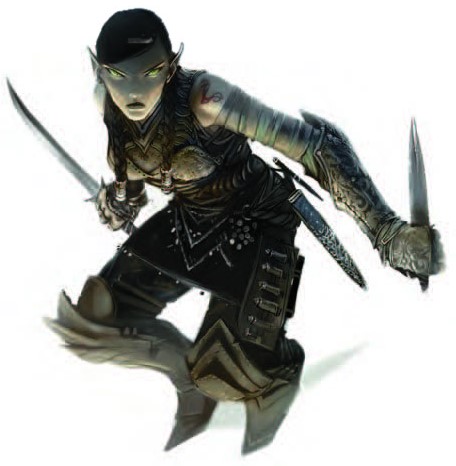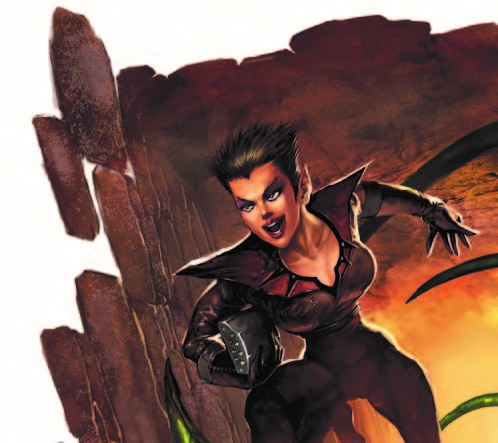

Ninja
The nobles are all talking amongst themselves, enjoying their quiet party. Lavish decorations blanket the room. An elvish woman stands in the corner, having bribed and disguised and bluffed her way in. She keeps her expression casual but never lets the host out of her sight, the baron over these lands who just raised taxes on the peasantry for the third time this month. She grips the kunai beneath her robes, waits for the opportune moment, then ducks into the nearest shadow and vanishes.
Creating a Ninja
Ninja is a Hybrid Class of Monk and Rogue, usually a guerrilla peasant taking on the nobility but they can be found among all ranks and types of warriors.
Quick Build
You can make a Ninja quickly by following these suggestions. First, Dexterity should be your highest ability score, followed by Wisdom. Second, choose the Criminal background.
Class Features
As a Ninja, you gain the following class features
Hit Points
- Hit Dice: 1d8 per Ninja level
- Hit Points at 1st Level: 8 + your Constitution modifier
- Hit Points at Higher Levels: 1d8 (or 5) + your Constitution modifier per Ninja level after 1st
Proficiencies
- Armor: None
- Weapons: Simple weapons, shortswords
- Tools: Thieves' tools, disguise kit, poisoner's kit
- Saving Throws: Dexterity, Wisdom
- Skills: Choose three from Acrobatics, Athletics, Deception, History, Insight, Intimidation, Perception, Performance, Persuasion, Religion, Sleight of Hand, and Stealth
Equipment
You start with the following equipment, in addition to the equipment granted by your background:
- (a) a shortsword or (b) any simple weapon
- (a) a shortbow and quiver of 20 arrows or (b) a shortsword
- (a) a burglar's pack, (b) a dungeoneer's pack, or (c) an explorer's pack
- Thieves' tools and 10 darts
If you are using starting wealth, you have 4d4 x 10 gp
Finesse Training
At 1st level, you are trained in unarmored combat styles using monk weapons, which are shortswords and any simple melee weapons that don't have the two-handed or heavy property. Darts also count as monk weapons for you.
You gain the following benefits while you are unarmed or wielding only monk weapons and you aren't wearing armor or wielding a shield:
- You can use Dexterity instead of Strength for the attack and damage rolls of your monk weapons.
- Your AC equals 10 + your Dexterity modifier + your Wisdom modifier.
Certain ninja clans use specialized forms of the monk weapons. For example, you might use a shortsword with a slightly curved single-edged blade (called a wakizashi) or darts that have four pointed blades (called shurikens). Whatever name you use for a monk weapon, you can use the game statistics provided for the weapon in chapter 5 of the Player's Handbook.
Sneak Attack
Beginning at 1st level, you know how to strike subtly and exploit a foe's distraction. Once per turn, you can deal an extra 1d6 damage to one creature you hit with an attack if you have advantage on the attack roll. The attack must use a finesse or a ranged weapon.
You don't need advantage on the attack roll if another
enemy of the target is within 5 feet of it, that enemy
isn't incapacitated, and you don't have disadvantage on
the attack roll.
The amount of the extra damage increases as you gain levels in this class, as shown in the Sneak Attack column of the Ninja table.
Ki
Starting at 2nd level, your training allows you to harness the mystical energy of Ki. You have a number of Ki Points equal to your Argent Fist level.
You can spend these points to fuel various Ki features. You start knowing three such features: Flurry Strike, Step of the Wind, and Shadow Arts. You learn more Ki features as you gain levels in this class.
You regain all expended Ki Points when you finish a short or long rest. You must spend at least 30 minutes of the rest meditating in prayer to regain your Ki points.
Some of your ki features require your target to make a saving throw to resist the feature's effects. The saving throw DC is calculated as follows:
Ki Save DC
Flurry Strike
When you use two-weapon-fighting with a pair of monk weapons, you can spend 1 ki point to make one attack with each of those weapons as a bonus action instead of just with the off-hand weapon.
Ninja
| Level | Proficiency Bonus |
Sneak Attack |
Unarmored Movement |
Features |
|---|---|---|---|---|
| 1st | +2 | 1d6 | — | Finesse Training, Sneak Attack |
| 2nd | +2 | 1d6 | +10ft | Unarmored Movement, Ki |
| 3rd | +2 | 1d6 | +10ft | Combat Style |
| 4th | +2 | 1d6 | +10ft | Ability Score Increase, Slow Fall |
| 5th | +3 | 2d6 | +10ft | Uncanny Dodge |
| 6th | +3 | 2d6 | +15ft | Combat Style Feature |
| 7th | +3 | 2d6 | +15ft | Evasion |
| 8th | +3 | 2d6 | +15ft | Ability Score Increase |
| 9th | +4 | 3d6 | +15ft | Infiltration Expertise |
| 10th | +4 | 3d6 | +20ft | Extra Attack |
| 11th | +4 | 3d6 | +20ft | Combat Style Feature |
| 12th | +4 | 3d6 | +20ft | Ability Score Increase |
| 13th | +5 | 4d6 | +20ft | Acculturate |
| 14th | +5 | 4d6 | +25ft | Impostor |
| 15th | +5 | 4d6 | +25ft | Cloak of Shadows |
| 16th | +5 | 4d6 | +25ft | Ability Score Increase |
| 17th | +6 | 5d6 | +25ft | Combat Style Feature |
| 18th | +6 | 5d6 | +30ft | Elusive |
| 19th | +6 | 5d6 | +30ft | Ability Score Increase |
| 20th | +6 | 5d6 | +30ft | Perfect Self |
Step of the Wind
You can spend 1 ki point to take the Disengage or Dash action as a bonus action on your turn, and your jump distance is doubled.
Shadow Arts
As an action. you can spend 2 ki points to cast darkness, darkvision, pass without trace, or silence. without providing material components.
Unarmored Movement
Starting at 2nd level, your speed increases by 10 feet. This bonus increases when you reach certain Ninja levels, as shown in the Ninja table.
At 9th level, you gain the ability to move along vertical surfaces and across liquids on your turn without falling during the move.
You only gain the benefits of this feature while not wearing armor or wielding a shield.
Combat Style
At 3rd level, you choose a style of combat to specialize in. You choose from among Daisho, Karate, or Shuriken, all detailed at the end of the section. Your choice grants you features at 3rd, 6th, 11th, and 17th levels.
Ability Score Increase
When you reach 4th level, and again at 8th, 12th, 16th and 19th level, you can increase one ability score of your choice by 2, or you can increase two ability scores of your choice by 1. As normal, you can't increase an ability score above 20 using this feature.
Slow Fall
At 4th level, you can use your reaction when you fall to reduce any falling damage you take by an amount equal to five times your Ninja level.
Uncanny Dodge
Starting at 5th level, when an attacker that you can see hits you with an attack, you can use your reaction to halve the attack's damage against you.
Evasion
Beginning at 7th level, you can nimbly dodge out of the way of certain area effects, such as a red dragon's fiery breath or an ice storm spell. When you are subjected to an effect that allows you to make a Dexterity saving throw to take only half damage, you instead take no damage if you succeed on the saving throw, and only half damage if you fail.
Infiltration Expertise
Starting at 9th level, you can unfailingly create false identities for yourself. You must spend seven days and 25 gp to establish the history, profession, and affiliations for an identity. You can't establish an identity that belongs to somebody else. For example, you might acquire appropriate clothing, letters of introduction, and official-looking certification to establish yourself as a member of a trading house from a remote city so you can insinuate yourself into the company of other wealthy merchants.
Thereafter, if you adopt the new identity as a disguise, other creatures believe you to be that person until given an obvious reason not to.
Extra Attack
Beginning at 10th level, you can attack twice, instead of once, whenever you take the Attack action on your turn.
Acculturate
Starting at 13th level, you can gain the ability to speak and understand any language by carefully listening to it being spoken for at least an hour. This includes accents and jargon necessary to pass as a native speaker of a particular dialect.
Impostor
At 14th level, you gain the ability to unerringly mimic another person's speech, writing, and behavior. You must spend at least three hours studying these three components of the person's behavior, listening to speech, examining handwriting, and observing mannerisms.
Your ruse is indiscernible to the casual observer. If a wary creature suspects something is amiss, you have advantage on any Charisma (Deception) check you make to avoid detection.
Cloak of Shadows
By 15th level, you have learned to become one with the shadows. When you are in an area of dim light or darkness, you can use your action to become invisible. You remain invisible until you make an attack, cast a spell, or are in an area of bright light.
Elusive
Beginning at 18th level, you are so evasive that attackers rarely gain the upper hand against you. No attack roll has advantage against you while you aren't incapacitated.
Perfect Self
At 20th level, when you roll for initiative and have no ki points remaining, you regain 4 ki points.
Combat Styles
Daisho
Daisho literally means "big little", and refers to a combat style focused on dual-wielding melee monk weapons, especially longswords (katanas) and shortswords (wakizashis).
Daisho specialists often take the Dual Wielder feat.
Daisho Specialty
At 3rd level, you gain proficiency with longswords, and longswords are considered monk weapons for you. While wielding two melee monk weapons, you cannot be disarmed of either weapon while you still hold the other (you can be disarmed of both weapons at once).
Dual Blades
Starting at 6th level, when you successfully hit a creature with a melee weapon attack, you can immediately spend 1 ki point to gain advantage on your next melee weapon attack against that creature with a weapon in your other hand this turn.
Dragon Blades
Starting at 11th level, you can spend up to 3 ki points as a bonus action to give one nonmagical melee monk weapon you are wielding a bonus to attack and damage rolls equal to the number of ki points spent. This bonus lasts for one minute, and the weapon counts as magical for the duration. You can use this feature on two weapons you are wielding as part of the same bonus action, but you must spend ki points separately for each weapon. You cannot use this feature on a weapon already under the effect of this feature.
Whirlwind Blades
Starting at 17th level, while wielding a melee monk weapon in each hand, you can spend 3 ki points as an action to spin your blades rapidly through any square you can reach. You can use up to 15 feet of movement as part of this action; this movement does not provoke opportunity attacks, and any square you threaten during this movement is within the area of this effect. Each creature within the area of effect must make a Dexterity saving throw. On a failed save, the creature takes damage as though hit by both your weapons; on a successful save, they take half as much damage.
Karate
Karate literally means "empty hand", and refers to a combat style focused on fighting with unarmed strikes.
Karate Specialty
Starting at 3rd level, your unarmed strikes become finesse monk weapons with a damage die of 1d4 instead of 1. This die increases to 1d6 at 6th level, 1d8 at 11th level, and 1d10 at 17th level. In addition, when you use the Attack action with an unarmed strike or a monk weapon on your turn, you can make one unarmed strike as a bonus action.
Dragon Fist
Starting at 6th level, your unarmed strikes count as magical for the purposes of overcoming resistance and immunity to nonmagical attacks.
In addition, whenever you hit a creature with an unarmed strike, you can spend 1 ki point to impose one of the following effects on that target:
- It must succeed on a Dexterity saving throw or be knocked prone.
- It must make a Strength saving throw. Ir it fails, you can push it up to 15 feet away from you.
- It can't take reactions until the end of your next turn.
Wholeness of Body
At 11th level, you gain the ability to heal yourself. As an action, you can regain hit points equal to three times your Ninja level. You must finish a long rest before you can use this feature again.
Quivering Palm
AI 17th level. you gain the ability to set up lethal vibrations in someone's body. When you hit a creature with an unarmed strike. you can spend 3 ki points to start these imperceptible vibrations, which last for a number of days equal to your Ninja level. The vibrations are harmless unless you use your action to end them. To do so, you and the target must be on the same plane of existence. When you use this action, the creature must make a Constitution saving throw. If it fails, it is reduced to 0 hit points. If it succeeds, it takes 10d10 necrotic damage.
You can have only one creature under the effect of this feature at a time. You can choose to end the vibrations harmlessly without using an action.
Shuriken
Shuriken literally means "hand hidden blade", and refers to a combat style focused on concealable throwing weapons such as darts or daggers.
Shuriken Specialty
Starting at 3rd level, you can draw and sheathe concealed light thrown weapons as quickly and easily as if they were not concealed. You may still have to make a Sleight of Hand check to keep this movement hidden from others. In addition, you can draw and sheathe any number of light thrown monk weapons at any time on your turn.
Piercing Blades
Starting at 6th level, you can roll a d6 in place of the damage die of any thrown light monk weapon. This die increases to a d8 at 11th level and a d10 at 17th level.
Returning Weapon
Starting at 6th level, immediately after making a ranged attack with a thrown light monk weapon, you may spend a ki point to have the weapon immediately reappear in your hand.
Whirlwind of Knives
Starting at 11th level, if you have at least 10 light thrown monk weapons on your person, you can spend 3 ki points as an action to rapidly draw and throw all of these weapons at once. Each creature in a 15 foot cone must make a Dexterity saving throw. A creature takes damage equal to three of your Piercing Blades dice on a failed save, and half as much damage on a successful one. The weapons used by this feature reappear where they were drawn from at the end of this action.
Sudden Edge
Beginning at 17th level, you can make opportunity attacks with light thrown monk weapons to the weapon's first range.
Multiclassing
Prerequisites
To qualify for multiclassing into the Ninja class, you must meet these prerequisites:
Dexterity 13 or higher.
No levels of Rogue or Monk.
If you have any levels of Ninja, you cannot multiclass into Rogue or Monk.Proficiencies
When you multiclass into the Ninja class, you gain the following proficiencies:
Simple Weapons, Shortswords, one of your choice from Thieves' Tools, Disguise Kit, or Poisoner's Kit

Thanks for Reading!
A special thank you to all the redditors on r/DnDHomebrew who helped me refine this!
DUNGEONS & DRAGONS, D&D, Wizards of the Coast, Forgotten Realms, the dragon ampersand, Player’s Handbook, Monster Manual, Dungeon Master’s Guide, D&D Adventurers League, all other Wizards of the Coast product names, and their respective logos are trademarks of Wizards of the Coast in the USA and other countries. All characters and their distinctive likenesses are property of Wizards of the Coast. This material is protected under the copyright laws of the United States of America. Any reproduction or unauthorized use of the material or artwork contained herein is prohibited without the express written permission of Wizards of the Coast.
©2016 Wizards of the Coast LLC, PO Box 707, Renton, WA 98057-0707, USA. Manufactured by Hasbro SA, Rue Emile-Boéchat 31, 2800 Delémont, CH. Represented by Hasbro Europe, 4 The Square, Stockley Park, Uxbridge, Middlesex, UB11 1ET, UK.

